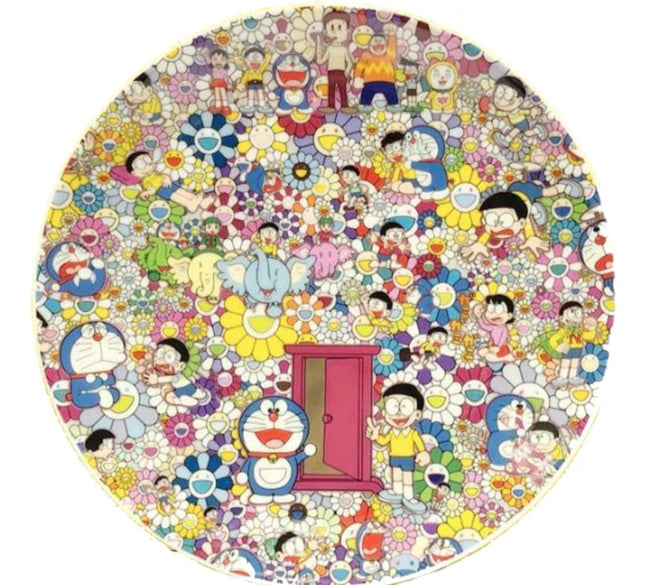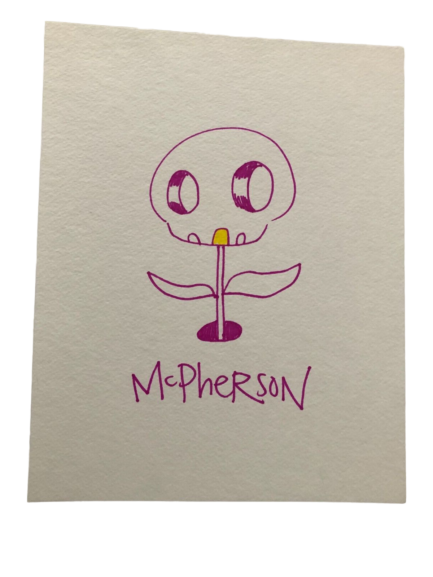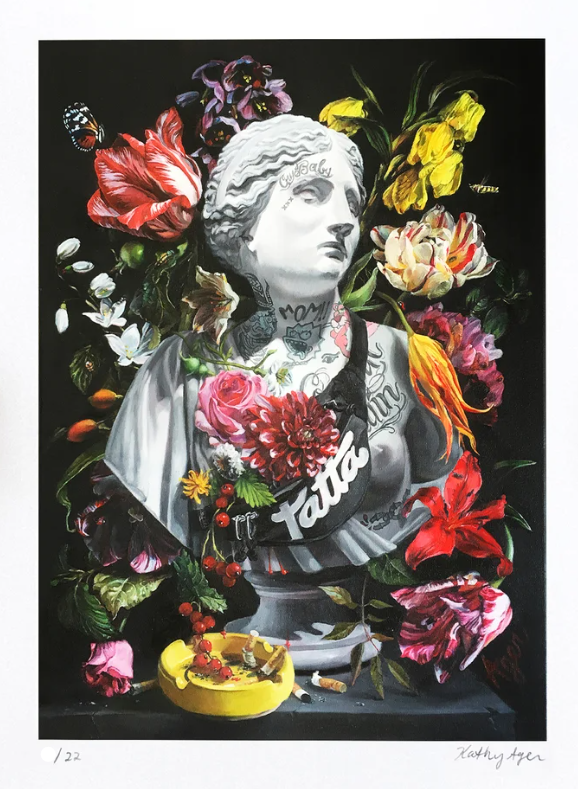
Flowers & Plants
-

Takashi Murakami TM/KK Doraemon Exhibition Tokyo Archival Pigment Plate by Takashi Murakami TM/KK
Doraemon Exhibition Tokyo Plate Limited Edition Archival Pigment Print Art on Ceramic Plate Artwork by Famous Artist Takashi Murakami TM/KK. 2017 Limited Edition Size 9" Collectible Art Plate Takashi Murakami's Intersection of Traditional and Pop Culture Takashi Murakami, a renowned artist whose work has consistently blurred the lines between fine art and pop culture, created a piece for the Doraemon Exhibition in Tokyo that captures the essence of this fusion. The exhibition piece, a limited edition 9-inch ceramic plate, features Murakami's signature style, often incorporating brightly colored anime and manga characters into traditional artistic formats. Artistic Elements and Cultural Influence Murakami's work on the Doraemon Exhibition plate is an archival pigment print that brings street pop art's vibrancy to the ceramic medium. This artwork stands out for its amalgamation of characters from the popular Japanese series 'Doraemon' with Murakami's distinctive flower motifs and designs. The characters are set against a backdrop of many flowers, creating a complex, eye-catching pattern that represents Murakami's exploration of contemporary Japanese society and otaku culture within the context of historical artistic practices. Murakami's Unique Style and the Art World Murakami's approach often involves a dialogue between different cultural elements, combining traditional Japanese artistic techniques with the mass appeal of anime and manga. His method is rooted in the "Superflat" concept, which he coined to describe the cultural commentary embedded in his artworks. This style is evident in the Doraemon Exhibition plate, where the flattened pictorial plane and the juxtaposition of characters suggest a deeper narrative on the influence of pop culture in our lives. Pop Art, Street Art, and Their Confluence By incorporating elements of street pop art and graffiti artwork into his ceramic plate design, Murakami contributes to the ongoing conversation about the validity and importance of pop culture in the art world. He elevates the perception of animated characters by placing them within the context of 'high art,' challenging preconceived notions about the value and meaning of pop and street art. Collectibility and Murakami's Global Impact The Doraemon Exhibition plate is a piece of art and a collectible item that has garnered attention from art collectors and enthusiasts worldwide. Murakami's ability to traverse the line between art and commodity has made his works highly sought after, and pieces like the Doraemon plate continue to shape the landscape of contemporary art collecting. Through these collectibles, Murakami has left a significant mark on global art culture, influencing new generations of artists and collectors alike. This Doraemon Exhibition plate by Takashi Murakami is a testament to the transformative power of pop culture within the art world and its ability to create new dialogues and understandings across different mediums and cultural backgrounds.
$541.00
-

Tara McPherson Gold Tooth Skull Flower Original Marker Drawing by Tara McPherson
Gold Tooth Skull Flower Original Pink Purple Marker Drawing by Tara McPherson on Card Stock Paper, Modern Street Pop Artwork. 2006 Signed Original Magic Marker Drawing Size 9x11.5 of a Skull Flower with Gold Tooth "Gold Tooth Skull Flower," an original marker drawing by Tara McPherson, is a striking example of modern street pop artwork that blends the macabre with the delightful. Created in 2006, this signed piece, measuring 9x11.5 inches, illustrates a skull flower characterized by a single gold tooth—a symbolic feature that offers a glimpse into McPherson's unique artistic universe. Rendered in pink and purple marker on card stock paper, the drawing exemplifies McPherson's approach to her subjects, which often intertwines themes of the surreal with human emotions. The skull, a symbol frequently associated with mortality and the transience of life, is given a new lease on life by transforming it into a flower—a representation of growth, beauty, and renewal. The gold tooth adds a playful twist to the otherwise sad symbol of the skull, injecting humor and lightness into the piece. This juxtaposition is a common thread in McPherson's work, where she seamlessly merges contrasting themes to create artwork that is both thought-provoking and accessible. This work stands out in street pop art for its distinctive style and the engaging way it invites viewers to reinterpret familiar symbols. McPherson's art often graces both the walls of city streets and the halls of galleries, reflecting the growing acceptance and appreciation of street art within the broader art community. In "Gold Tooth Skull Flower," McPherson continues to explore the endless possibilities of simple materials such as magic markers, proving that impactful art is not confined to traditional mediums or methods. Her work remains a celebrated part of the street pop art movement, known for its ability to challenge perceptions and delight audiences with its whimsical take on the everyday.
$803.00
-

Kathy Ager Pitter Patta Goes My Heart Giclee Print by Kathy Ager
Pitter Patta Goes My Heart Giclee Print by Kathy Ager Artwork Limited Edition Print on Hand Deckled 290gsm Rag Watercolor Fine Art Paper Graffiti Pop Street Artist. 2023 Signed & Numbered Limited Edition of 22 Artwork Size 9x12 Exploring the Fusion of Classical and Contemporary in "Pitter Patta Goes My Heart" "Pitter Patta Goes My Heart," a giclée print by Kathy Ager, is a compelling artwork that seamlessly marries classical art sensibilities with the raw, vibrant ethos of Street Pop Art and graffiti Artwork. This limited edition piece, one of only 22, exemplifies the innovative trajectory of contemporary art. Measuring a modest 9x12 inches, the work is printed on hand-deckled 290gsm rag watercolor fine art paper, which adds a tactile, organic feel to the viewing experience. Kathy Ager, renowned for her unique blend of classical and modern art, presents a visual narrative that juxtaposes a Greco-Roman bust's timelessness with graffiti's ephemeral nature. The subject, a statue, is adorned with tattoos, an element borrowed from the world of street art, symbolizing the permanence of ink on skin contrasted with the enduring nature of marble. The tattoos are not mere decorations; they tell stories, reveal hidden truths, and express the silent words of the artwork's subject. The lush, vibrant flora surrounding the figure bursts forth with life and color, reminiscent of the still-life paintings of old masters, yet imbued with a sense of urgency and defiance characteristic of street art. This choice of composition creates a dialogue between the enduring and the transient, the revered and the rebellious. The Significance of Limited Editions in the Art Market In the realm of fine art prints, the scarcity of a limited edition run significantly enhances the value of each piece. "Pitter Patta Goes My Heart" is signed and numbered by the artist, which further authenticates its exclusivity and appeals to collectors who value the intersection of fine art and street culture. This limited availability often leads to a sense of urgency among buyers and collectors, keen to own a part of this transient art form that captures the zeitgeist of contemporary culture. Materials and Medium: The Choice of Giclée Printing Giclée printing is renowned for its high fidelity to the original artwork, capable of reproducing the nuances of color and texture with remarkable precision. By opting for giclée printing on hand-deckled watercolor paper, Kathy Ager ensures that each print of "Pitter Patta Goes My Heart" resonates with the quality and intention of her original painting. This medium also offers a nod to street art's preference for unorthodox canvases, reflecting the unpredictable and often fleeting canvases of urban landscapes upon which graffiti artists work. Impact of "Pitter Patta Goes My Heart" in Street Pop Art & Graffiti Artwork Kathy Ager's artwork is a testament to the evolving nature of Street Pop Art and graffiti Artwork. It pushes the boundaries by incorporating classical motifs, thus bridging the historical and the contemporary. The choice to infuse a classical bust with the sensibilities of street art is a powerful statement on the ever-changing definitions of high art and popular culture. This artwork is not simply a piece to be hung on a wall; it is a catalyst for conversation, a statement of cultural fusion, and a marker of artistic evolution. As Street Pop Art and graffiti Artwork continue to gain recognition in fine art, pieces like "Pitter Patta Goes My Heart" challenge traditional notions of what is considered 'gallery-worthy' and blur the lines between street and elite. In conclusion, Kathy Ager's "Pitter Patta Goes My Heart" is a striking example of contemporary art's power to transcend boundaries. It is an homage to the past, a commentary on the present, and a beacon for the future of art. By blending elements of classical art with the dynamism of Street Pop Art and graffiti, Ager has created a visual lexicon that speaks to a broad audience and carves a niche in the art market that is distinctly her own.
$180.00




